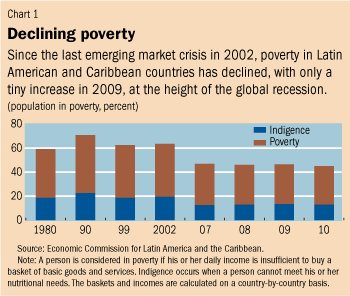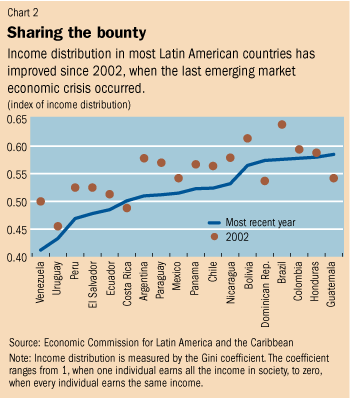Spreading the Wealth
Finance & Development, March 2011, Vol. 48, No. 1
Poverty and inequality have declined in Latin America in recent years, but there is a lot more to do
THE years following the 2002 emerging market crisis have been good ones for Latin America. Economies grew smartly and there was a significant reduction in poverty and a slight improvement in income distribution—with only a small setback during the Great Recession that began in 2008. But even with these positive developments, poverty, inequality, and economic and social marginalization remain prevalent in many Latin American countries—which historically have had among the most skewed income distribution in the world.
The improvements reflect not only strong economic growth in the region, which averaged more than 4 percent during the period, but also better social policies and an increase in the number of workers toiling in the formal economy rather than the less-productive underground, so-called informal, economy, where wages and social protection are weaker.
Moreover, better monetary, spending, and tax policies—as well as strong demand for commodities key to the region’s economies—enabled Latin American countries in the main to weather the global crisis better than advanced economies. In the past, worldwide downturns generally sent Latin American economies reeling—and poverty rates skyrocketing. This time the reduction in poverty recorded in the boom years before the crisis continued into 2010.

Despite sharp variation from country to country, poverty rates for the region as a whole dropped significantly between 2002 and 2008. On average, 44 percent of Latin American citizens were unable to satisfy basic nutritional and non-nutritional needs in 2002; by 2008 that number had fallen to 33 percent (see Chart 1). Moreover, indigence—the level below which people cannot satisfy their food needs—also declined markedly, from about 19 percent in 2002 to less than 13 percent in 2008.

Like poverty, income inequality has also declined in most countries in Latin America and the Caribbean during the early years of the 21st century. If the so-called Gini coefficient is used to measure how equally incomes are distributed, 15 out of 18 economies surveyed in the region—Argentina, Bolivia, Brazil, Chile, Colombia, Ecuador, El Salvador, Honduras, Mexico, Nicaragua, Panama, Paraguay, Peru, Uruguay, and Venezuela—experienced improved income distribution (see Chart 2). In at least 11 of these economies the improvement was larger than 5 percentage points. Only in Costa Rica, the Dominican Republic, and Guatemala did wealthier segments of society increase their share of total income. The Gini coefficient ranges between zero and 1. In an economy in which one person has all the income, the coefficient is 1. It is zero when everyone has the same income.
But income distribution in the region remains heavily skewed. The average per capita income of households in the upper 10 percent is about 17 times that of the poorest 40 percent, a slight improvement over 2002, when it was 20 times higher. So a number of households may have escaped poverty, but they are not benefiting much from economic growth. That should come as no surprise. Poverty, although endemic, responds much more to economic cycles than income distribution. Lack of income equity is a long-standing condition that reflects serious problems of social stratification and wealth inequality that have been handed down from generation to generation.
The improvements in poverty and income distribution are explained in large part by growth and government policies and the interaction between them. Many economies in the region have made significant efforts to increase the resources available to implement social policies. On average, social spending rose from 12.2 percent of gross domestic product (GDP) during 1990–91 to 18 percent of GDP during 2007–08. As a share of overall public spending, social programs grew from 45 percent to 65 percent.
Among key social policies, conditional transfer programs, which pay households that engage in socially useful behavior such as keeping children in school, have also helped improve income distribution and reduce poverty. Other important programs include unemployment insurance, recruitment subsidies, and job creation programs.
Latin America was largely untouched by the first phase of the global crisis, which severely roiled financial markets in Europe and the United States. But the financial crisis spread to the real economy—which produces goods and services—and world trade shriveled in late 2008 and early 2009. Latin American output, as measured by GDP, fell 1.9 percent in 2009—the biggest annual contraction in two decades. But unlike during previous crises, many governments were able to undertake policies to mitigate the effects of the downturn on their citizens. Social policies became part of the effort—along with countercyclical taxing, spending, and monetary policies—that governments in the region took to soften the negative economic and social effects of the global crisis.
The generalized recovery in 2010 for most Latin American and Caribbean countries—led to a great extent by the adoption of countercyclical policies combined with improving conditions in the global economy—is expected to improve social conditions further. According to the latest estimates by the Economic Commission for Latin America and the Caribbean (ECLAC), the region’s poverty rate rose a tiny bit (from 33 percent to 33.1 percent) in 2009 and is expected to have declined a full percentage point in 2010, to 32.1 percent. Extreme poverty, which rose 0.4 percentage point in 2009, is expected to have fallen back to its 2008 level of 12.9 percent.
In addition to economic growth and better social policies, changes in labor markets helped reduce poverty and income inequality. In many countries jobs in the formal sector increased, which, together with rising hourly wages, helped lower-income households relatively more than better-off households.
As encouraging as the improvements were, structural constraints could significantly hamper future improvements in overall economic welfare.
• Despite the recent movement of some workers from the informal to the formal sector, informal employment remains prevalent. Informal jobs, by their nature, are designed to remain out of sight and are seldom as productive as jobs in the formal sector. The productivity gap between the formal and informal sectors leads to wage differentials and inequality. Moreover, because informal employers often do not pay social security taxes, their workers usually are not as well protected as workers in the formal sector, leaving many people with inadequate health insurance and old-age protection.
• The unequal distribution of financial assets and real assets means that much of Latin American society is poorly equipped to weather economic and social instability.
• Less access to health and education by poorer people makes it harder to even out income distribution.
All these problems contribute to the region’s continued structural productivity gaps—both within countries and compared with the rest of the world (see “Face-to-Face with Productivity” in this issue of F&D). That pervasive lagging productivity translates into low-paying employment and transmits poverty and inequality from generation to generation in a vicious cycle that is hard to break.
To deal with these structural issues, ECLAC has proposed a comprehensive development strategy to eradicate poverty and inequality. It places equality at the center of development. It establishes a vital role for government and calls for public-private partnership in the setting of economic and social policies.
ECLAC identifies three interlinked policies in its approach to production: industrial policy that focuses on the most innovative sectors, technology policy that increases and disseminates know-how, and policies to support small and medium-sized enterprises.
Employment, social, and education policies are at the core of the equality agenda. Labor policy alone does not generate employment, but it can help countries adapt to new conditions in the global market with fiscally and socially responsible economic protection for workers.
Social equality and economic growth are not necessarily at odds: the great challenge is to find ways they can reinforce each other. ■
Alicia Bárcena is the Executive Secretary of the United Nations Economic Commission for Latin America and the Caribbean.
References:
Economic Commission for Latin America and the Caribbean (ECLAC), 2010, Time for Equality: Closing Gaps, Opening Trails (Santiago, Chile).
———, 2010, Social Panorama of Latin America 2010 (Santiago, Chile).


